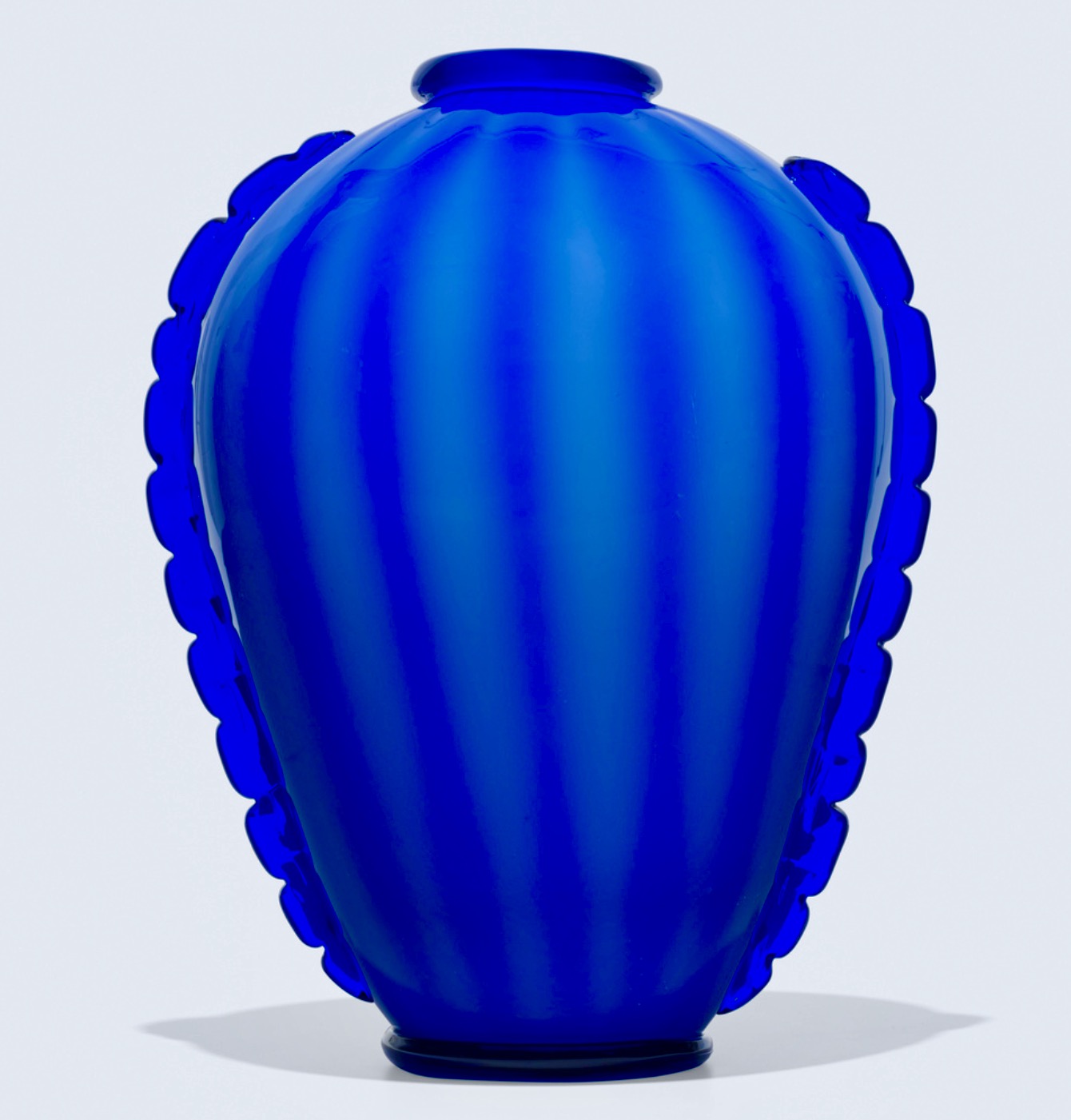

Title: Rare Vintage Italian Venetian Blue Cobalt Glass Vase
Shipping: $29.00
Artist: N/A
Period: 20th Century
History: Art
Origin: Southern Europe > Italy
Condition: N/A
Item Date: N/A
Item ID: 401
Italian glass artist Zecchin-Martinuzzi. Incamiciato Vase 1933 Italy. A vintage piece of vintage Italian cobalt blue glass lightly ribbed design. "Incamiciato glass" with cobalt sides and applications. Size (12 1/2 H X 1- 1/4 W) (32x26x 23 cm.) SIGNED WITH A TWO-LINE ACID STAMP TO UNDERSIDE (MADE in ITALY) NAPOLEONE MARTINUZZI (1892-1977) IS ONE OF THE MOST INFLUENTIAL NOVECENTO SCULPTORS, HIS NAME ALONE EVOKES IMAGES OF REMOTE ELEGANCE AND ARCHETYPAL GLORY. IN 1921 HE BECAME DIRECTOR OF THE MURANO MUSEUM AND IN 1925 THE ARTISTIC DIRECTOR AT VENINI. HIS USE OF LARGE SCALE FORMS FROM CLASSICAL ANTIQUITY EXECUTED IN BRIGHT COLORS SET A NEW STANDARD FOR MURANO GLASS DESIGN. IN 1932 MARTINUZZI LEFT VENINI TO FOUND HIS OWN FIRM ZECCHIN-MARTINUZZI - VETRI ARTISTICI E MOSAICI (WITH FRANCESCO ZECCHIN). WHILE THE COMPANY ONLY LASTED FOR A FEW YEARS, ITS HIGHLY REFINED PRODUCTIONS HAD A PROFOUND INFLUENCE ON MURANO GLASS FOR DECADES TO COME. THE SAME VASE SOLD AT WRIGHT AUCTIONS - IMPORTANT ITALIAN GLASS- ON 20 MAY, 2014 FOR $9,375. In the 1930s, thick, sculptural, opaque glass would become the norm, with Martinuzzi’s Pulegoso as an aesthetic point of reference and inspiration. What distinguishes Murano glass made during the 1930s is the overall quality! Venice remained a playground for the rich and famous, and Murano glass became a treasured luxury item for the well-appointed modernist home. This accounts for both the quality and rarity of Murano glass during the 1930s. Martinuzzi would leave Venini in 1931 to start his own short lived company, Zecchin-Martinuzzi, which produced very high quality neoclassic inspired vessels and sculpture in variations of Pulegoso, Lattimo (milk) and Incamiciato (cased) glass. In keeping with this trend, some Murano companies made outright reproductions of Martinuzzi’s work, while others were influenced by his style, materials, and techniques. During the 1930s, Murano glass underwent a dramatic transformation: from transparent to opaque, from lightweight and delicately drawn, to thick, massive and sculptural. This change in style and material can be traced back to 1925 when the Venini company split in two. Giacomo Cappellin and Vittorio Zecchin left to establish their own company, MVM Cappellin, while Paolo Venini was left to find a new artistic director. Venini hired the popular and well connected sculptor Napoleone Martinuzzi, and this was the beginning of a new era. Between 1925 and 1928, both companies continued to produce Soffiato glass designed by Vittorio Zecchin. But Martinuzzi had his own ideas.
Vittorio Zecchin (born May 21, 1878, Murano, Italy–died April 15, 1947, Murano, Italy) was an influential Italian painter, tapestry maker, furniture designer, and glass designer. Zecchin attracted critics and clientele of the time with his glass designs that simultaneously evoked ancient and Renaissance styles while also instilling a new modern sensitivity. Zecchin became an influential figure in the conversation among Italian artists and designers inspired by the avant-garde sentiment in Venice during the early years of the 20th century. Born on the island of Murano, just outside of Venice, renowned as Italy’s artistic glassmaking center, Zecchin earned early exposure to the art of glassmaking as his father, Luigi, was a glassblower himself. Vittorio Zecchin, became very familiar with the different glassmaking techniques used in Murano. In 1913 and 1914, Zecchin, with the assistance of Artisti Barovier, designed a small number of Secessionist-style mosaic glass pieces that were exhibited in Munich in 1913 and at the Venice Biennale in 1914. These pieces earned Zecchin great acclaim from critics and the market. In 1918, he began to design a small production of glass works. This time, he made transparent glass designs with gold and enamel accents and in forms taken from the 16th and 17th centuries. He developed a uniquely modern style and created his most acclaimed pieces, including the Veronese Vase (1921), with its shape inspired by a glass in a painting by Renaissance painter Paolo Veronese exhibited at the Gallerie dell’Accademia in Venice. Zecchin, became the most renowned and modern glassmaker of his time. He designed transparent and lightweight pieces with elegant lines and simple shapes that clearly distinguished themselves from the highly ornate glass pieces made before his time. He often chose delicately translucid yet intense colors, such as yellow, green, amethyst, and blue, for his mostly monochromatic pieces. The iridescent quality of many of his pieces was the result of an elaborate process in which he placed the pieces, while they were still hot, in tin or titanium vapors, a process that is no longer in practice Zecchin continued to collaborate with the main Murano glass makers and designers of the time such as: Ferrro Toso in 1930; A.V.E.M. in 1932; Barovier Seguso Ferro–with Archimede Seguso, later known as Seguso Vetri d’Arte, in 1933; F.lli Toso in 1938; and after that S.A.L.I.R. From 1934 until his death in 1947, Zecchin taught in several Venetian institutions including the “Scuola per L’Industria Vetaria,” the apprentice school “Abate Zanetti,” and the technical institute “Instituto Vendramin Corner.” He also published two booklets with personal drawings. One about the history of glass and the other about the history of mosaic.